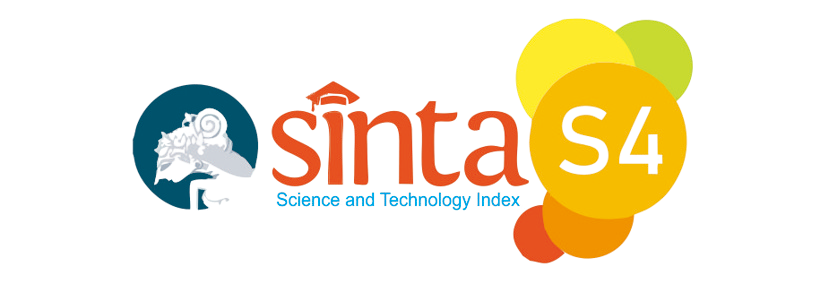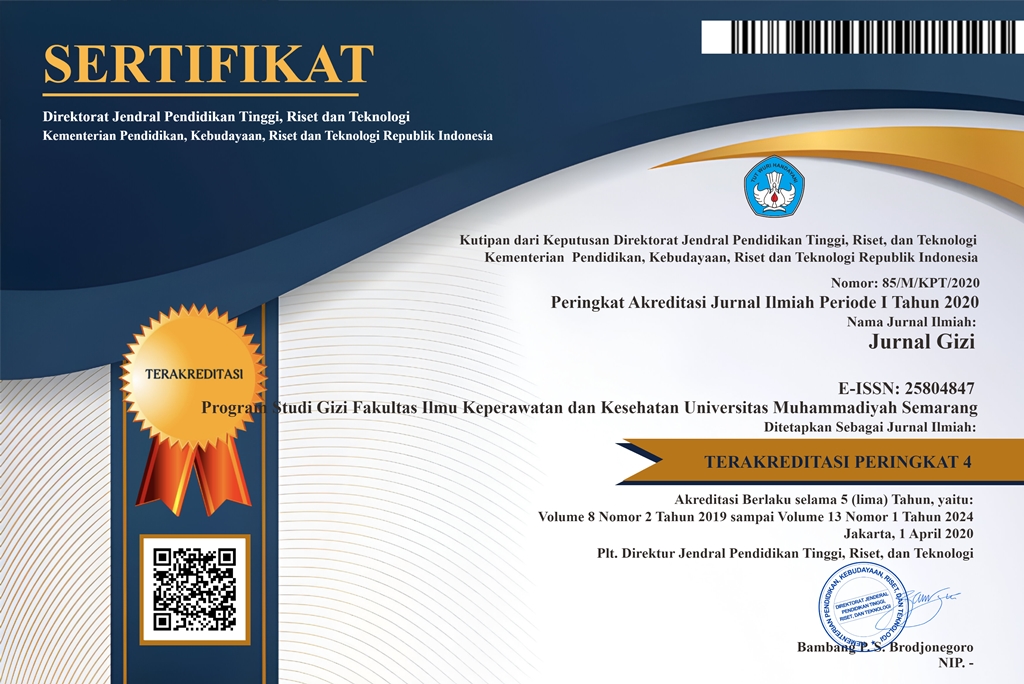Profil Tekanan Darah Berdasarkan Asupan Lemak, Serat dan IMT Pasien Hipertensi
(1)
(2)
(3)
(*) Corresponding Author
Abstract
Hypertension is a condition when a person experiences an increase in blood pressure above normal or chronically in a long time. Objective the general objective of this study was to determine the relationship intake of fat, fiber and BMI with blood pressure in hypertensive patients hospitalized at the Roemani Muhammadiyah Semarang.
The type of research conducted explanatory research with cross sectional approach. The number of samples of 25 respondents consisting of hypertensive patients with complications and without complications of hospitalized at the hospitasls Roemani Muhammadiyah Semarang. Analysis of the data normality using the Kolmogorov-Smirnov because the number of samples taken > 15 samples. Bivariate analyzes to examine the relationship between two variables using Spearman Rank test for abnormal distribution data.
The result showed 72.0% of samples largely female based on the largest age group
ranging from 51-60 years of age amounted to 36.0% of the sample, and the nutritional status of most is overweight / obese amounted to 68.0%. Based on systolic blood pressure and diastolic hypertension classified at the highest level is very mild, very mild systolic blood pressure by 40.0% of the sample and the diastolic blood pressure is very light for 60.0% of the sample. The intake of fat (> 30%) as many as 68.0% of the samples, not enough fiber intake (<20 g) as much as 68.0% of the sample. Statistical analysis between fat intake with systolic blood pressure (p value = 0.000 <0.05), fat intake with diastolic blood pressure (p
value = 0.004 <0.05), fiber intake with systolic blood pressure (p value = 0.001 <0.05), fiber intake with diastolic blood pressure (p value = 0.008 <0.05), whereas BMI relationship with systolic blood pressure (p value = 0.000 <0.05), BMI with diastolic blood pressure ( p value = 0.002 <0.05).
The conlusion is the study shows that there is a relationship between the intake of fat, fiber , and BMI with systolic and diastolic blood pressure.
Keywords: Fat intake, fiber intake, BMI, Blood Pressure, Hypertension
The type of research conducted explanatory research with cross sectional approach. The number of samples of 25 respondents consisting of hypertensive patients with complications and without complications of hospitalized at the hospitasls Roemani Muhammadiyah Semarang. Analysis of the data normality using the Kolmogorov-Smirnov because the number of samples taken > 15 samples. Bivariate analyzes to examine the relationship between two variables using Spearman Rank test for abnormal distribution data.
The result showed 72.0% of samples largely female based on the largest age group
ranging from 51-60 years of age amounted to 36.0% of the sample, and the nutritional status of most is overweight / obese amounted to 68.0%. Based on systolic blood pressure and diastolic hypertension classified at the highest level is very mild, very mild systolic blood pressure by 40.0% of the sample and the diastolic blood pressure is very light for 60.0% of the sample. The intake of fat (> 30%) as many as 68.0% of the samples, not enough fiber intake (<20 g) as much as 68.0% of the sample. Statistical analysis between fat intake with systolic blood pressure (p value = 0.000 <0.05), fat intake with diastolic blood pressure (p
value = 0.004 <0.05), fiber intake with systolic blood pressure (p value = 0.001 <0.05), fiber intake with diastolic blood pressure (p value = 0.008 <0.05), whereas BMI relationship with systolic blood pressure (p value = 0.000 <0.05), BMI with diastolic blood pressure ( p value = 0.002 <0.05).
The conlusion is the study shows that there is a relationship between the intake of fat, fiber , and BMI with systolic and diastolic blood pressure.
Keywords: Fat intake, fiber intake, BMI, Blood Pressure, Hypertension
Full Text:
PDFArticle Metrics
Abstract view : 2189 timesPDF - 1045 times
DOI: https://doi.org/10.26714/jg.6.2.2017.%25p
Refbacks
- There are currently no refbacks.
Diterbitkan oleh: Program Studi Gizi (D3 dan S1)
Fakultas Ilmu Keperawatan dan Kesehatan
Universitas Muhammadiyah Semarang
Sekretariat: Jl. Kedungmundu Raya No. 18 Semarang
Contact Person : Hapsari Sulistya Kusuma, S.Gz, M.Si (+62 85 6 41 536 553)

This work is licensed under a Creative Commons Attribution 4.0 International License.










.png)
.png)
_.png)